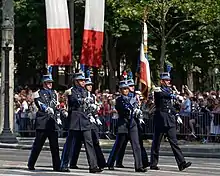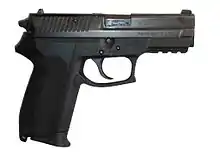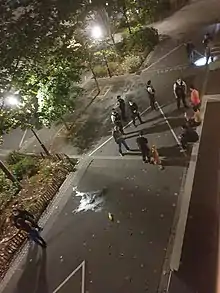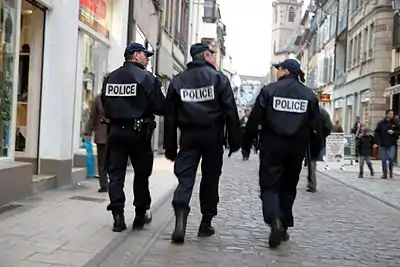National Police (France)
The National Police (French: Police nationale), formerly known as the Sûreté nationale, is one of two national police forces, along with the National Gendarmerie, and the main civil law enforcement agency of France, with primary jurisdiction in cities and large towns. The other main agency is the military Gendarmerie, with primary jurisdiction in smaller towns and rural and border areas. The National Police comes under the jurisdiction of the Ministry of the Interior and has about 145,699 employees (in April 2008). Young French citizens can fulfill the mandatory service Service national universel (SNU) in the police force.[4][5]
| National Police Police nationale | |
|---|---|
.svg.png.webp) | |
| Motto | Pro patria vigilant [1] |
| Agency overview | |
| Formed | April 23, 1941 [2][3] (unification of existing units) |
| Preceding agency |
|
| Employees | 145,200 (2015) |
| Jurisdictional structure | |
| National agency | France |
| Operations jurisdiction | France |
| Size | 551,695 km² |
| Population | 67.2 million |
| Governing body | Cabinet of France |
| General nature | |
| Operational structure | |
| Overviewed by | General Directorate of the National Police |
| Headquarters | Paris, France |
| Minister responsible | |
| Agency executive |
|
| Directorates | List of Directorates
|
| Facilities | |
| Helicopters | 0 (see Sécurité Civile) |
| Website | |
| Official website (in French) | |

The National Police operates mostly in large cities and towns. In that context:
- it conducts security operations (patrols, traffic control, identity checks)
- under the orders and supervision of the investigating magistrates of the judiciary, it conducts criminal enquiries, serves search warrants, etc.; it maintains specific services ("judicial police") for criminal enquiries.
Organization
The police is commanded by the director-general (directeur général de la police nationale) who is currently Jean-Marc Falcone. The director-general is directly in charge of the General Directorate of the National Police (French: Direction Générale de la Police nationale) (DGPN) and the immediate subordinate of the Minister of the Interior.[6]
The police is then sub-divided into (central) directorates which are composed of sub-directorates :
- Direction des ressources et des compétences de la police nationale (Directorate of Resources and Competences of the National Police; DRCPN):[7] fusion of the Direction de la formation de police nationale (Directorate of Training of the National Police; DFPN) and Direction de l'administration de la police nationale (Directorate of Administration of the National Police; DAPN)
- Direction centrale de la Police judiciaire (Central Directorate of the Judicial Police; DCPJ): charged with all criminal investigations (this mission is fulfilled in the Paris area by the Direction Régionale de Police Judiciaire de Paris nicknamed after its address "36 Quai des Orfèvres", often without the number; the national headquarters of the PJ, as it is usually called in French, are actually located at 11 rue des Saussaies, in the Ministry of the Interior). The main Sub-Directorates of the Judicial Police are:
- Sous-direction anti-terroriste "SDAT" (Anti-Terrorism Sub-Directorate): elite counter-terrorist task-force.
- Sous-Direction de la lutte contre la criminalité organisée et la délinquance financière "SDLCODP" (Sub-Directorate for the struggle against organized crime and financial delinquency): It includes all the National Investigation Offices specialized in that field, except the National Itinerant Criminality Struggle Office (managed by the Gendarmerie Nationale)
- Sous-Direction de la police technique et scientifique "SDPTS" (Sub-directorate of forensics and crime scene investigation)
- Sous-Direction de lutte contre la cybercriminalité "SDLC" (Sub-directorate for the struggle against computer and internet crime)
- Direction centrale de la sécurité publique (Central Directorate of Public Security; DCSP): patrol and response, misdemeanour investigations, emergency help; approximatively 80% of the workforce.
- Groupes d'Intervention de la Police Nationale (Intervention Groups of the National Police; GIPN): Nine regional SWAT teams.
- Direction centrale de la police aux frontières (Central Directorate of Border Police; DCPAF): performs identity checks with "La douane française" (official name: Direction générale des Douanes et Droits Indirects) and handles illegal immigration.
- Inspection générale de la police nationale (General Inspectorate of the National Police, IGPN): headed by the Inspector General and responsible for internal affairs. In the Paris Area, these tasks are assigned to a dedicated service—the Inspection Générale des Services (General Inspectorate of the Services).
- Direction centrale des compagnies républicaines de sécurité (Central Directorate of the Republican Security Companies; DCCRS): riot police, motorway police, and mountain rescue; commonly referred to as the CRS.
- Service de coopération technique internationale de police (Technical International Police Co-operation Service; SCTIP).
- Service de protection des hautes personnalités (Important Persons Protection Service; SPHP): VIP protection such as foreign diplomats and also responsible for the protection of the President of the French Republic through the 'Groupe de Sécurité de la Présidence de la République'.
- The Unité de Coordination de la Lutte Antiterroriste (UCLAT; Counterterrorism Struggle Coordination Unit) and its Recherche Assistance Intervention Dissuasion (Research, Assistance, Intervention, Deterrence; RAID) unit.
The Préfet de Police, currently Didier Lallement, under direct orders of the Minister of the Interior, manages the Préfecture de Police de Paris which includes all police and security services in Paris and neighbouring départements, those services not being under the control of the director-general. The police forces in the other départements of the Île-de-France region are under the direct command of the Préfet (Département Prefect) in charge, being himself under the supervision of the Préfet de Police as far as the active on-the-field police work is concerned, and under the control of the director-general for the rest.
Former directorates
As of 1 July 2008, the following two National Police directorates:
- Direction de la surveillance du territoire (Directorate of Territorial Surveillance; DST) – counter-intelligence, counterespionage, counterterrorism
- Direction centrale des renseignements généraux (Central Directorate of General Information; DCRG or RG) – police intelligence, records, research, analysis (and also policing gambling and horse racing, two activities which are now in the hands of the "Service central des courses et jeux" SCCJ, a unit of the Judicial Police)
were merged into one single domestic intelligence agency titled the Direction centrale du renseignement intérieur (DCRI). The DCRI was placed directly under the Ministry of the Interior.[8]
Ranks
The National Police is divided into three corps, in the terminology of the French Civil Service, in ascending order of seniority:
- The Corps d'encadrement et d'application (Management and Enforcement Corps) corresponds approximately to the enlisted and non-commissioned ranks in a military force, or to constables and sergeants in a British-style civil police force.
 Gardien de la paix stagiaire (keeper of the peace, intern") 1st year after school.
Gardien de la paix stagiaire (keeper of the peace, intern") 1st year after school. Gardien de la paix (keeper of the peace)
Gardien de la paix (keeper of the peace) Brigadier
Brigadier Brigadier-chef
Brigadier-chef Major
Major
- The Corps de commandement (Command Corps) corresponds approximately to the lower commissioned ranks of a military force, or the grades of inspector and chief inspector in a British-style civil police force. These ranks were previously known as inspecteurs if detectives or officiers de la paix if uniformed, although CRS officers always used the current ranks.
 Lieutenant student
Lieutenant student Lieutenant intern
Lieutenant intern Lieutenant (formerly Officier de la paix or Inspecteur)
Lieutenant (formerly Officier de la paix or Inspecteur) Capitaine (formerly Officer de la paix principal or Inspecteur principal)
Capitaine (formerly Officer de la paix principal or Inspecteur principal) Commandant (formerly Commandant or Inspecteur divisionnaire)
Commandant (formerly Commandant or Inspecteur divisionnaire) Commandant divisionnaire
Commandant divisionnaire
Same insignia as Commandant but with gold oak leaf Commandant divisionnaire functionnel
Commandant divisionnaire functionnel
Same insignia as Commandant but with silver oak leaf
- The Corps de conception et de direction (Conception and Direction Corps) corresponds approximately to the higher commissioned ranks of a military force, or to grades of Chief superintendent and chief officers in a British-style civil police force.
 Commissaire de police (Chief superintendent)
Commissaire de police (Chief superintendent) Commissaire divisionnaire (Ass. Chief Constable)
Commissaire divisionnaire (Ass. Chief Constable) Contrôleur général (Controller General) the equivalent of a D.A.C. or Assistant commissioner. In the 'provincial constabularies', this is the rank of an Chief Constable.
Contrôleur général (Controller General) the equivalent of a D.A.C. or Assistant commissioner. In the 'provincial constabularies', this is the rank of an Chief Constable. Inspecteur général (Inspector General) This is the equivalent of a Deputy Commissioner in Metropolitan Police of London.
Inspecteur général (Inspector General) This is the equivalent of a Deputy Commissioner in Metropolitan Police of London. Directeur des services actifs (Director of the Active Services) Equivalent of a Commissioner in London in a British-style police force
Directeur des services actifs (Director of the Active Services) Equivalent of a Commissioner in London in a British-style police force
All the ranks insignia may be worn either on the shoulders or on the chest. In the latter they are square-shaped.
Prior to 1995 two civilian corps ("Inspecteurs" and "Enquêteurs") existed in which plainclothes officers were given the training and authority to conduct investigations. The closest American equivalent is the detective.
Equipment
Weapons


In 1935, the French police used a variety of side arms, both revolvers and semi-automatic pistols, notably comprising the MAS 1873, the MAS 1892, the FN M1900, Ruby pistols, and a variety of privately purchased weapons.
Immediately after the Second World War, a variety of military side arms was used, often captured weapons provided by the Army or French-produced German-designed weapons, such as the Mauser HSc or the Walther P38 for sidearms, and the Karabiner 98k rifle.
In 1951, a standardisation was performed on the RR 51 pistol[9] in 7.65×17mm and on the MAS-38 and MAT-49 for submachine guns. From 1953, in the context of heightening violence of the Algeria War, CRS units were upgraded to the 9×19mm MAC Mle 1950.
In the early 1960s, large-caliber revolvers were introduced, culminating with the introduction of the Manurhin MR 73 and the Ruger SP101. In the 80s, a process to standardize revolvers was initiated. The 1970s also saw the introduction of assault rifles (such as the SIG SG 543) to fend off heavily armed organised crime and terrorism.
In the 2000s, the police started switching to semi-automatic pistols and to the 9×19mm Parabellum cartridge. For some years, the standard sidearm in the National Police and the Gendarmerie Nationale was the PAMAS G1, which was French licensed and made. In 2003 both agencies made the biggest small arms contract since the Second World War[10] for about 250,000 SIG Sauer Pro SP 2022s, a custom-tailored variant of the SIG Pro, replacing the PAMAS-G1 and several other pistols in service. The weapons are planned to stay in service until the year 2022, hence the weapon name. It is possible the pistols will be used past 2022 as the agency purchased more pistols in late 2018 possibly indicating the pistols may be used beyond 2022. [11]
For greater threats the police use slightly modified Ruger Mini-14s purchased in the 1970s. More modern long guns like Remington 870, HK UMP and HK G36 are also issued.
Some sources have claimed the use of the Spectre M4 by the French National Police.
Cars
While the vast majority of vehicles are screen printed French brand (mainly Renault, Citroën and Peugeot), some service vehicles are provided by Ford and Opel. Plainclothes officers or specialised branches use vehicles from a variety of manufacturers.





 Police Motorcycle Yamaha FJR1300
Police Motorcycle Yamaha FJR1300 Unmarked anti crime unit (Peugeot 308)
Unmarked anti crime unit (Peugeot 308)
Pictures
 Police in the process of combing.
Police in the process of combing..jpg.webp) Police in the process of combing.
Police in the process of combing.
In popular culture
Television series
- Maigret (various television series)
- The Last Five Minutes (Les cinq dernières minutes) (1958–1996)
- Navarro (1989–2005)
- Commissaire Moulin (1976–2006)
- Police Judiciaire/P.J. (1997–2009)
- La Crim' (1999–2006)
- Commissaire Magellan (2009–)
- Les Cordier juge et flic (1992–2003)
- Commissaire Cordier (2004–2007)
- Julie Lescaut (1991–2014)
- Falco (2013–2016)
- Commissaire Valence (2002–2008)
- Engrenages (2005-)
See also
References
- "Police Nationale - Une force d'action et de protection au service de tous". Archived from the original on 2013-11-03. Retrieved 2013-06-23.
- "Loi du 23 avril 1941 portant organisation générale des services de police en France". criminocorpus.org (in French). March 13, 2008 – via criminocorpus.org.
- "Histoire".
- "France begins trial of compulsory civic service for teens". France 24. June 16, 2019.
- Williamson, Lucy (June 26, 2019). "France's raw recruits sign up for return of national service" – via www.bbc.com.
- Archived April 5, 2004, at the Wayback Machine
- "Direction des Ressources et des Compétences de la Police Nationale / Organisation - Police nationale - Ministère de l'Intérieur" (in French). Interieur.gouv.fr. Retrieved 2013-03-15.
- "Official announcement of the DCRI's launch on the website of the French Ministry of the Interior".
- "Nouvelle page 0". Littlegun.info. Retrieved 2013-03-15.
- Ayoob, Massad F.: The Gun Digest Book of SIG-Sauer: A Complete Look at SIG-Sauer Pistols, page 80. Gun Digest, 2004.
- "More SIG SP2022s For French Police -". December 5, 2018.
External links
| Wikimedia Commons has media related to |
- Official site of the French National Police (in French)
- Official site of the French Ministry of Interior (in French)
- Unofficial site of the National Police (in French)